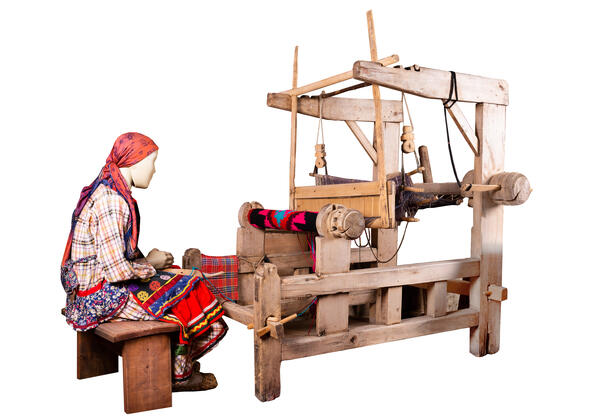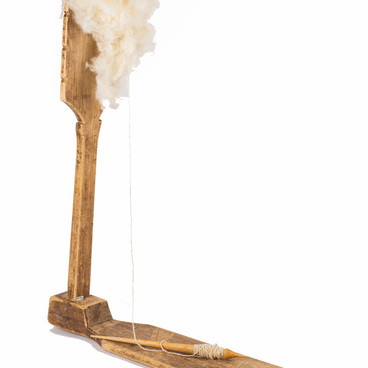The collection at the Ethnography Hall has a wooden handloom — a weaving loom that was made in the beginning of the 20th century. These handicraft devices were used to produce various types of napped, smooth, and woven fabrics, as well as linen, hemp, cotton, silk, and woolen rugs and other textile products. There hardly was a Russian peasant hut that made do without a loom: almost every peasant woman knew how to weave not only simple cloth sections, but also elegant tablecloths, towels, and napkins. This cumbersome device — with a large frame, two shafts, and other structural components — was put into the hut only when it was time to weave: a significant part of the time the disassembled weaving loom lay in the attic.
Before starting to weave, peasant women, with the help of a gauge ring, wound the spun threads on special spools and reels, and then wound them on a warp beam — one of the shafts in the weaving loom. Then the end of the thread was passed between the teeth of the reed, a kind of movable comb, was passed through the loop on one of the lifter heddles, and was fixed on the second shaft. That was how the warp was created — the longitudinal threads of the future fabric. The warp weave, like the machine itself, is called woven cloth, and weaving the warp means creating the basis of the fabric. The weft — the transverse threads — were unwound from a spindle placed in a heavy shuttle that was shaped like a boat.
While working at the loom, the weaver pressed the footboard, and one or more heddles with the warp threads passed through them rose, forming an opening between the threads. After that, she threw the shuttle into this opening, pressed another footboard, threw the shuttle back through another opening, and then pressed the threads against one another with her hand.
Basically, weaving, like spinning, was a nighttime job: during the day peasant women were busy with the housework, and during the summer they were also involved in field work. Even today, in some rural houses there are still manual weaving and carpet looms that require painstaking work, diligence, and patience. To produce artistic and ornamental rugs, and rugs with narratives (tapestries, kilims) that used to handmade, nowadays machines are used, but the basic structure has changed little over time. Conversely, industrial weaving looms have evolved into high-technology electronic equipment.
Before starting to weave, peasant women, with the help of a gauge ring, wound the spun threads on special spools and reels, and then wound them on a warp beam — one of the shafts in the weaving loom. Then the end of the thread was passed between the teeth of the reed, a kind of movable comb, was passed through the loop on one of the lifter heddles, and was fixed on the second shaft. That was how the warp was created — the longitudinal threads of the future fabric. The warp weave, like the machine itself, is called woven cloth, and weaving the warp means creating the basis of the fabric. The weft — the transverse threads — were unwound from a spindle placed in a heavy shuttle that was shaped like a boat.
While working at the loom, the weaver pressed the footboard, and one or more heddles with the warp threads passed through them rose, forming an opening between the threads. After that, she threw the shuttle into this opening, pressed another footboard, threw the shuttle back through another opening, and then pressed the threads against one another with her hand.
Basically, weaving, like spinning, was a nighttime job: during the day peasant women were busy with the housework, and during the summer they were also involved in field work. Even today, in some rural houses there are still manual weaving and carpet looms that require painstaking work, diligence, and patience. To produce artistic and ornamental rugs, and rugs with narratives (tapestries, kilims) that used to handmade, nowadays machines are used, but the basic structure has changed little over time. Conversely, industrial weaving looms have evolved into high-technology electronic equipment.



